 Adopting to LED light saves electricity, money and extra maintenance cost too. This happens only when you switch to High-Quality LED Lighting products only. Find out which factors you should consider from Packaging Labels for getting best quality Led light products from Market.
Adopting to LED light saves electricity, money and extra maintenance cost too. This happens only when you switch to High-Quality LED Lighting products only. Find out which factors you should consider from Packaging Labels for getting best quality Led light products from Market.
LED and CFL bulbs have revolutionized energy-efficient lighting. Even here you can say that CFLs are a temporary solution to energy-efficient lighting, while long lasting, durable, more efficient, eco-friendly… LED lights are replacing incandescent bulbs broadly. You can easily find out best quality Led light products in the market, simply considering some important factors like power factor, light appearances, CRI, etc. available on packaging labels. Get informed about such key factors in details here, and select the best LED for the best result.
6 Factors to identify Best Quality LED lights
There are six factor you should consider to buy best quality LED light for any application.
- Lumens Per Watt
- Power Factor
- CRI (Colour Rendering Index)
- Colour temperature
- Heat sink
- Life of LED Chip
1. Lumens Per Watt
Gone are days when the strength of light bulbs was measured in watts. Actually, it is a measure of power. In time of incandescent light bulbs, the strength for lighting was checked by wattage rating, wherein a 100-watt lamp can put out more light compared to a 60-watt lamp. Reason is that incandescent lamps use the same filament material but 98% of the energy is wasted on heat and only 2% is spent on making light. So, the only way to raise their light output is to increase the wattage. It was our mindset to look wattage on the light packaging to know how bright it would be. But actually, wattage rating has nothing to do with how bright the bulb is.
Newer types of bulbs consume much less power compared to old-style incandescent light bulbs. For ex. LED light bulbs spend over 90% of their input energy on light instead of heat.
The new unit of measurement for light bulbs is Lumens. Lumen scale describes how much light or brightness the human eye can perceive – the higher the number of lumens, the brighter the light. For example, an average 100-watt incandescent bulb can produce about 1,600 lumens. All modern light bulb packaging shows how many lumens the bulb can produce.
The right way to measure efficiency of any light sources is based on how many lumens they can produce per watt. We consider kilometers per littler to measure fuel efficiency of the car, just like the lumens-per-watt rating to check how energy efficient the bulb is. 9 to 12 watts LEDs can produce the same number of lumens as standard 40- or 60-watt bulbs. So if you want to replace a 60-watt bulb, go for an LED bulb that produces close to 800 lumens; while for a 40-watt bulb, go for 450 lumens.
One thing for sure is that lots of brands produce LED lighting products having their own standards. You can choose the best one considering the following guidelines.
The chart indicates that as high as Lumens-per-watt of the lighting, wattage consumption goes down. Ultimately, you can save more money with low-wattage lighting. Let’s understand clearly with practical example.
Let’s take and example, your requirement for the 2BHK home lighting is 14300 total Lumens.
Now, if you purchase lighting with 110 lumens-per-watt (tagged as Best Quality Standard in the chart), you just require 130 watts power consumption
If lighting comes with 100 lumens-per-watt, you require 143 watts power consumption.
For lighting with 90 lumens-per-watt, you require 159 watts power consumption.
For lighting with 80 lumens-per-watt, you require 179 watts power consumption.
For lighting with 70 lumens-per-watt, you require 204 watts power consumption. This is almost 56% more compared to lighting with 110 lumens-per-watt.
Here you can simply check the difference that if you opt for lighting with 70 lumens-per-watt, you wattage consumption would be increased upto 56% than of lighting with 110 Lumens-per-watt.
Let’s check the real market scenario with leading brands.
Check out: Price List of Top Rated LED Bulbs
If you are really concerned about wattage consumption, then have a look at this chart: EverReady LED Bulb offer 100 Lumens-per-watt, also Charlston GlowUp offers 90 Lumens-per-watt but SYSKA SSK-LB offers only 70 Lumens-per-watt for the same 5W power consumption.
Next important thing is that no doubt you can save a good for opting light with higher Lumens-per-watt, but you may have to pay bit more as light offering higher Lumens-per-watt are quite expensive. However, this would be initial investment, as the cost will be recovered by its amazing power-efficacy in less than 2 to 4 years. So, whenever you look for the best Led Light bulb, you should first search for the bulbs that produce the number of lumens you want for enough brightness. Then, checkout the lumens-per-watt rating to find the bulb that is most energy efficient.
Note: Light Packaging don’t show lumens-per-watt directly, take total lumens that shown on the packaging and divided with Wattage and the product will be lumens-per-watt.
2. Power Factor
Power factor is really a vital parameter to check quality of any electrical instrument. Power Factor is the effective ratio of real power (used power at load) to apparent power from your meter. Intelligent buyer is who not only check wattage of any LED Light but who also check power factor with wattage.
Let’s take a real example of 2 BHK Home. Total LED wattage for 2BHK Home is around 120-150 Watt. Lights with high lumens can luminate your room around 120watt, but if you opted for quality LED Panel light then you need to go around 180-200 watt. Let’s assume general life of LED is 20,000 Hours. However there are LED Lights available in market that give more than 50,000 hours of life warranty.
| Total Wattage | Power Factor | Actual Consumption (Watt) |
Cost per life |
| 120 | 0.65 | 185 | 3692 |
| 120 | 0.7 | 171 | 3428 |
| 120 | 0.8 | 150 | 3000 |
| 120 | 0.9 | 133 | 2666 |
In simple example, if 7watt LED light packaging label shows 0.7 power factor then it actually consume 10watt. In short, LED lights with power factor of 0.9 and above are high in quality.
3. CRI (Color Rendering Index)
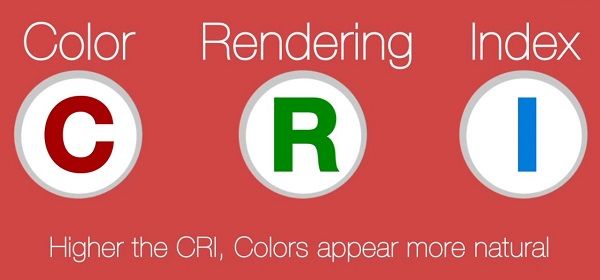 CRI may be new to you…but it is important one to consider if you are concerned about the light source’s ability to show object colors “realistically” or “naturally”. It measures the effect a bulb has on the perceived color of objects based upon an ideal or natural light source. For ex. it is indicator of how “natural” an object’s color appears when illuminated …as blue looks blue or green; red looks red or purple; etc.
CRI may be new to you…but it is important one to consider if you are concerned about the light source’s ability to show object colors “realistically” or “naturally”. It measures the effect a bulb has on the perceived color of objects based upon an ideal or natural light source. For ex. it is indicator of how “natural” an object’s color appears when illuminated …as blue looks blue or green; red looks red or purple; etc.
CRI is rated on a scale from 0 to 100 and only Sunlight is classified as having a CRI of 100. Colors look exactly like they should underneath a light scoring CRI of 100. So the simple concept: the higher the CRI, the better colors will look and if the lower the CRI, the worse colors will look.
The chart indicates that LED is second one with higher rating of CRI following incandescent/ Halogen. However, research and development continues to improve LED lighting up to 100.
Generally, lighting with a CRI of 85 to 90 is considered to be “very good” while a CRI of 90 or greater are “excellent” that can be used for tasks requiring very accurate color discrimination. You require lighting with high CRI for places like art galleries, museums, or jewelry stores where objects are on display. And for residential lighting, there’s no need of bulbs with a very high CRI, especially in places like the living room or the kitchen. Lighting with a CRI below 70 make colours look washed out, and can even change the color of objects. For example, the lights you see in highway fixtures is a very yellow light having a very low CRI that makes colors harder to differentiate.
4. Color temperature
LEDs are available in wide colour temperature range from 2800K to 6500K as mentioned below.
Warm white: 2700K-3500K (dusk time yellow light)
Neutral white: 4000K-4500K (bright sun light little yellow)
Cool white: 5000K-6500K (pure white, cool day light)
In LED color temperature of around 2700K to 3300K gives same colour tone (yellowish light) as conventional incandescent or halogen lamps.
Some local companies do not describe colour temperature specifications in Kelvin, but they simply label them with “Natural White” or “Office White”. Branded Companies always mention actual specifications so be sure that which colour temperature you are selecting.
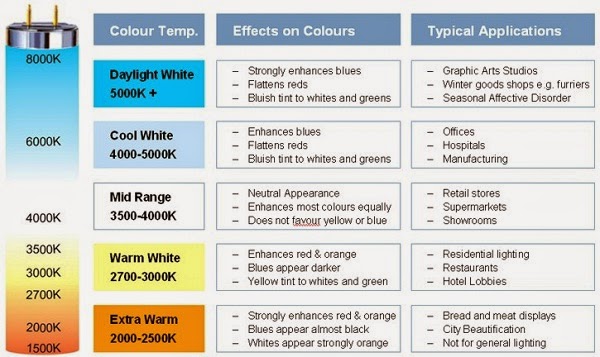 Image courtesy: Theledspecialist.co.uk
Image courtesy: Theledspecialist.co.uk
Let’s check real example of same picture taken under all available LED Light colour temperature. Generally buyer choose Cool White for home and office use. Warm white is used in restaurant and hotels.
The colour temperature surely affects the colours of things you are seeing than actual. So be careful while selecting colour temperature of LED light according to your application and need.
5. Heat sink
Don’t forget that for LEDs to last a long time, they need a heat sink. That’s why LED bulbs have metal fins that go down the side, making them look different than the classic Edison-style bulb. Heat sink dissolves any excess heat and maintains the LEDs at best operating temperature as well gives boost in terms of life to main LED chip.
6. Life of LED Chip
At this point, LEDs really score high as its life typically ranges from 20,000 to 50,000 hours. Therefore, LEDs are idyllic for use in areas where maintenance is difficult or long life is essential.
Still confused which brand you should select? Don’t worry we have done homework for you. Check this out: Top Indian branded LED Bulbs Compared
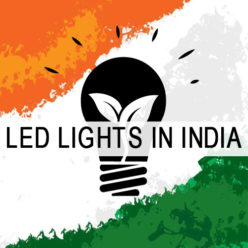
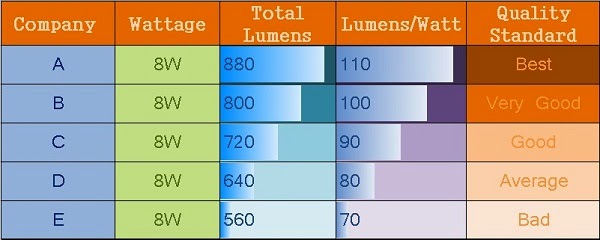
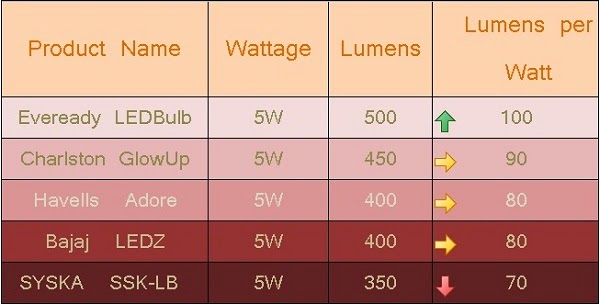
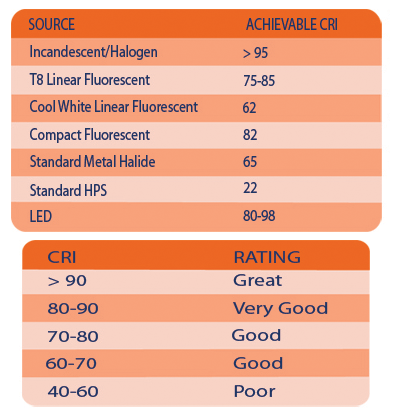
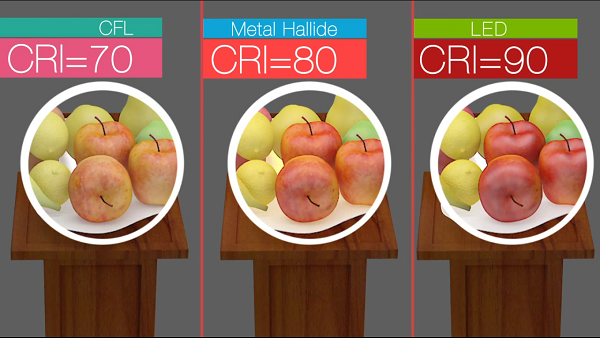
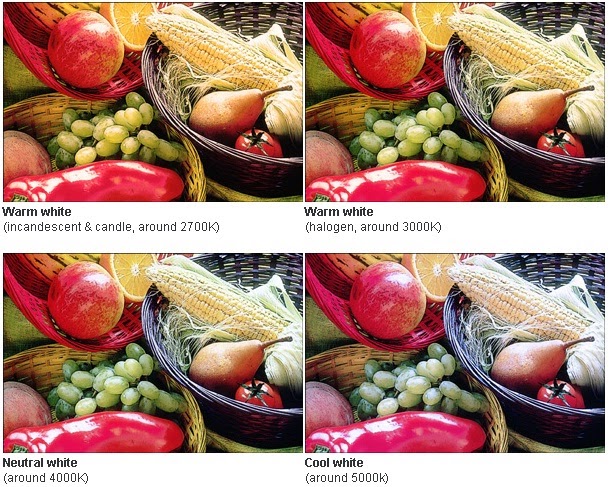
Wow !!! Really Excellent. The way you have adopted, the common Indians can understand everything from such elaborations.
Thanks for your kind words…. :)
Great information. It would be nice to do a quick comparison of the leading LED Lamps in the market…especially showing how high “Lumens per Watt” stands out in terms of “mercury in the LED” to proper “heat sink” for longer life. Haven’t come across such a comparison chart yet. A few days back, I bought Philips 14W LED (1400 Lumens), 6500K (just awesome brightness)., 80mAmp. I had 1 tornado 23W, one 20W usual CFL lamps in my Living room. This LED had 50lumens more than one CFL but that this LED is more than the 2 CFLs is an understatement. Only one CFL had 1100mAmp. Imagine the power consumption now (2 replaced with one of 80mAmp). Also, the CFL had lost it’s brightness over the months, years…to an extent it was unbearable. But my concern has been if Philips is using mercury, has a proper heat sink…one of the reason I wanted Syska. However, Syska has an awful Lumens/watt, couldn’t believe it. Need to do a bit more research and math before settling on a brand to replace my CFLs at home :)
Hi, Samrat
Thanks for your kind reply. We also have done comparison of top branded LED bulbs: http://www.ledlightsinindia.com/information/indian-led-bulbs-comparison
If you are choosing SYSKA then you still have to think about it, because there are also lots of good alternatives of it.
One naked secrets of LED lights, I need to reveal here is the life span of LED light.
1. Now-a-days most of standard quality LED chips have 50K hours of life.
2. 50K Hours LED chip life doesn’t mean your light will get failed, but in technical term if your LED chip is degraded below 80% of stated lumens then it called dead which actually working with lower lumens as per stated. This mean after 50K hours of service your LED light still give minimum 70-80% of lumens output.
This all thing is possible until LED manufacturer start using quality power supply which are not cheap.
Very useful information for comparing LED bulbs. I want to buy LED panels for my house to be installed in false ceiling. I want good quality but not so expensive ones, as I need 400 panels, price matter much. Kindly suggest me with that. Thanks.
Hi, Aakash
Thanks for your opinion and keep connecting with us. Sorry but you haven’t mentioned your budget.
I am never happy with the results of LED Panel light. You can go with downlight as downlights are more effective and more power saver than panel light.
1. Panel light technology waste your LED output Lumens while downlight direct reflect it to you. So downlight has 30% higher output.
2. Due to lower out out you have to select high watt panel light compared to downlight.
3. If you are choosing higher watt then you are not smart saver in terms of electricity.
4. Most important, LED used in downlights are more effective than panel light in terms of life.
My opinion is to go for Charlston Lights.
1. Cubie: Square LED Ceiling Down Light
2. MagicMoon: Round LED Ceiling Down Light
Is this recommendation of Charleston Cubie is same as of now in Feb 2017, or some better options are available ?????
Philips and Charlston are my recommend because they both are getting higher and higher in specification day by day.
we are offering good quality of panel lights in very resonable price with 2 years full replacement warranty with 50000 hours of Life for more detail about our product specification please write to us at sales@rstenergy.com and call to 9770855549
Hi, I ve got my new house constructed with ceiling area around 3000 sq feet(all false ceilng done). I want to install panel lights on the false ceiling and even other range is required. It would be appreciable if any of your sales person could contact me immediately for my requirement. I also need your latest price list for the same.
:- Er. Jasbir Singh
Mobile: 9501118333
Batala, Punjab (Pin 143505)
Useful info, but something is confusing. Regarding colour temperature, Theledspecialist.co.uk chart shows Warm White as suitable for residential lighting (and restaurants and hotel lobbies), mid range for retail stores, supermarkets and showrooms, and cool white for offices, hospitals, and manufacturing. Yet you go on to say “Generally buyer choose Cool White for home and office use. Warm white is used in restaurant and hotels.” This contradicts the chart with regard to home lighting. Which then is the right choice for home lighting? Can you confirm please? Thanks
Hi, Maximilian Quad
This data is found from the survey of top manufacturers and retail shops. We found out that most of Indian customers are going to choose Cool White for office and home use. Nowadays people are used to modern colours and designs, so cool white is best option for your modern interior. In cool white, all your colours seem as same it is (original), while in true/warm white you feel the mixing of little yellow tone and as a result the output colour will be different that original. For example, your pure white colour painted wall seem yellowish white (Yellow tone depends on which colour temperature you are choosing) in true or warm white.
Cool white is best for purpose of reading and work atmosphere. Warm and true white are used for decorative purpose as well as in wooden furniture.
There is not any hard and fast rule to use cool white or warm white. But in my opinion cool white is best for home and office for clear colour vision and productivity.
Hi Maximilian,
One other reason is that western countries are used to yellow colored lighting in homes too and they prefer yellow\warm white actually in homes too. My reasoning for their liking of warm white or yellow light is that they get really cold weather and sunshine is not there all through the year. So the warm light of a lamp is like sunlight to them.
In India we moved away to tube lights, probably to save electricity, which are usually cool white and we stuck with the same for CFLs too. Plus we have abundance of sunlight and we would rather see something cool rather than warm ;-)
Rgds,
Senthil Kumar.K
Does the THD of the LED bulb is important?. What is the normal THD of the LED bulbs available in India.
THD is somehow similar to power-factor. Power factor corrected driver has better THD.
There is no need to worry about THD & PF if energy consumption of your led product is less than 15 watt. Because it costs more for small products compare to saving of electricity.
It is hardly needed good THD(10%-25%) & PF(0.950-0.995) if energy consumption of your led product is greater than 30 watt.
Variation of THD & PF depends on brand and watt of led bulb. However many of them do not print THD on their product. But you can check Power Factor(PF) of this product.
Bad THD products produce EMI to line and affecting other product.
Bad PF products takes more energy than the real usage of this product.
Can you please do a same article for T5 28 w tube light comparison, as I cannot afford LED bulb’s. Appreciate it. I need to buy T5’s based on your reply for my new apt. Thank You.
Hi,
I too have my own review site as given below:
http://factsoflight.zohosites.com/
But you have done an even better job I guess. I think you could also talk about IP Rating and the L70 marking. These 2 points would be kind of value adds.
The Lumen Per Watt chart would do better to have Philips added to it.
Keep it going.
Rgds,
Senthil Kumar.K
Hello,
Your site is very informative…keep up the good work. Can you please help me out. I want to buy standard p4 LED’s with heat sink mounted. They should have very good lumens/watt. I am based in Pune and I am starting my own business.
Superb basic and to the point information. Very useful while planning to change home, society, office lighting, keep up the good work.
Dear surender , This is ashutosh from maharashtra we can provide LED products like LED bulb(0.5w to 9w),tube (18w),round panel light(3w to 18w),square panel light (3w to18w),round surface light(6w to 18w),square surface light(6w to 18w),corn light(5 to 39w),street light(24 to 50w), celing grill light,floodlight & highbays etc with 1 year warrenty for bulb & 2 years warrenty for other product.if you any requirement then call me we will discuss about it. Regards…..ashutosh(9960001738)
LifeLite LED lights provide high quality LED Lights with high Lumen Output and high power factor with 2 yr warranty on all the products.
syska led is realy high quality I ws installed syska and gt rich result heat 🔥 sink metal quality finishing ani thiner aal over standard is really awesome
That was explained in a lucid way. I appreciate that.
I just checked information printed on the cover of my Compact LED. There was no mention about Power factor, CRI and Color temperature. Can you suggest some LED brands that are transparent about the relevant information..
Greetings,
Vivek
Philips has all the info on LED light packs.
what is requirement of led companies for lighting technical staff
pls reply
regards
Which LED brands sells high CRI / TQS leds in India? or where can I get high CRI emitter chips?
Which LED bulbs would you suggest for chandelier/hanging light in the living room? There are total 07 E 27 bulb holders in the chandelier.
The best illustration on LED I have ever seen, and that too in India.
Thank you very much and I appreciate it. Wish all who wanted to buy LED would take a cue from your website.
Great grat information…. Many thanks to admin, writer. This article made my day.
can you please provide similar comparison of LED T5 tubes.
because no brands are giving power factor. Thanks
From where i can purchase natural white led or cfl i need for photography i searched a lott in photography store they showed sometimes else
WHICH LED ceiling light is good for home philips havells syska oreva ya veto ya other
HI,
I am interested in surface mount led lamps to install directly on ceilings. I do not want to spend money on false ceilings instead i can spend more on good quality led lights.
Please suggest good designer lights which can be mounted directly on ceiling.
Thanks.
I am going to buy 6 nos. Philips LED downlight for my 13×10 Living room and 4 nos. for 10×10 bed room.. but little bit confused between 5 and 7 watt..
Can any one suggest about that?
Also please suggest if any other better option is available in Pune..
good information.
earlier I thought only on lumen factor now I can compare on more specifications.
thanx
This site is really helpful.
I would like to know how many lumens will be required for a 300 sq.ft ( 10 ft × 30 ft ) ladies garment showroom.
I am planning on using track lights only.
Should i go for higher lumens per track light(less number of teack lighrs) or lower lumens per track light(more number of track lighrs).
I am not using the word watts because now i know the importance of lumens.
Any feedback shall be much appreciated.
Regards
Sam
real good information for me as i do sell LED lights as it helps save power in turn save environment.
it is true that down lights are always better compared to panel lights( edge lights).
i always recommend to go for down lights- other way back lit lights.
Wow really good information on LED lights.
It is an eye opener .
Thank you very much for your information.
Hi,
This is a very useful information. However it would be great if you can guide us on norms/ standards on import/ supply/ usage of LEDs in India as there are many brands available in market who are importing substandard products and supplying on a large scale.
SYSKA LED have great quality and performance ……
Go for syska
Please give me name & details of led panel which have high CRI percent.
We personally do not recommended LED panel light due to lowest performance due to its design.
So informative. Thank you!
My home is 1250 sq.ft. 2BHK
Please suggest me to buy LED Tube lights / bulb as per below details and it should long last 4-5 yrs
My budget max 3K-4K
Carpet area 900sqft
Hall 350sqft
Master bedroom 250sqft
Small bed 150sqft
Kitchen 100sqft
Hi,
If you selecting 120Lumens/watt LED light then here is your requirement details.
Drawing Room : 8 lights of 12-18 watt.
Master Bed : 4 lights of 12 watt.
Small Bed: 4 lights of 10 watt.
Kitchen: 4 Lights of 5-10watt
Best tool to calculate light requirement:http://www.charlstonlights.com/led-light-requirement-calculator
Very informative. Thanks. Can you advise how much lumen is required per 100 sq foot for a residence? So can select accordingly.
very informative!
Thanks for your reply!!
Which is the best led bulb in lumens and life
In this article we have covered best comparison chart of all best LED light companies of india.
Check out here: http://www.ledlightsinindia.com/information/indian-led-bulbs-comparison
But, how do one understand what a ‘lumen’ is, so that he or she can have an idea as to how many ‘lumens’ one need ?
A friend of mine gave me a simple idea.
Take for example, a ’40 Watts standard magnetic choke Tube Light’.
It will give us 1000 Lumen,as per the printing on the box, ie just 25 lumen per watt. This is grossly insufficient.
We will chose a figure that is 4 times brighter than this. ie 100 lumen per watt. This is exactly what the author has suggested.
Very informative. Though I have a question that is there any company who manufactures LEDs around 5000K temperature? My home is now in light brown – dark brown – red – white theme. I bought two LED bulbs – a 3000k and 6500k – both are destroying the colour theme of home. Can you please help me? I’ve to buy 10 – 15 LED bulbs for home. So I can’t take risk, that’s why I’m asking. Thanks in advance.
good enough information for the people who does not aware of LED at all…
Excellent information…. But if we compare the parameters discuss, as of March 2019, Wipro panel led is better than Phillips.
Wipro – 6W, 487 lumen, 81 Lumen/Watt
Phillips – 5W, 300 Lumen, 60 Lumen/Watt
Both showing 80percent efficiency and CRI greater than 80.
Can you please suggest if Wipro better than Phillips?
Hello Admin.
I am looking to put LED panel/downlights in my hall sizing 140sqft.
I would like to know, how many lights would I require?
Would 8 LED panel/downlights do or is it overkill?
No problem with the budget, willing to buy the best of the lot.
I just need to make sure the Hall is lightened up properly, I no need to use tube light as the wiring is all concealed.
Also, should I go for downlight or panel LED?
Thanks so much for taking the pain to explain so many factors in details. Really appreciate your efforts.
Hello,
We bought 4000k (natural white) syska false celing light for our living room, but while testing these light it is looking as little yellowish , so should I go for 4000 k or 6500 k led false celing light.
please advise.
Somehow the quality of light of fluorescent tube seems better and warmer than led tube even when both of them indicate 6500k on the packing